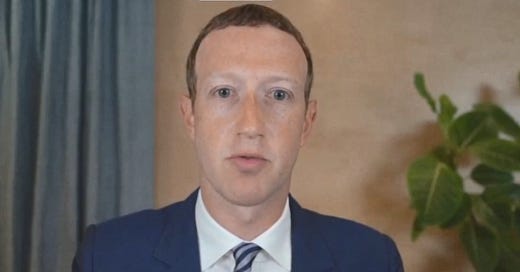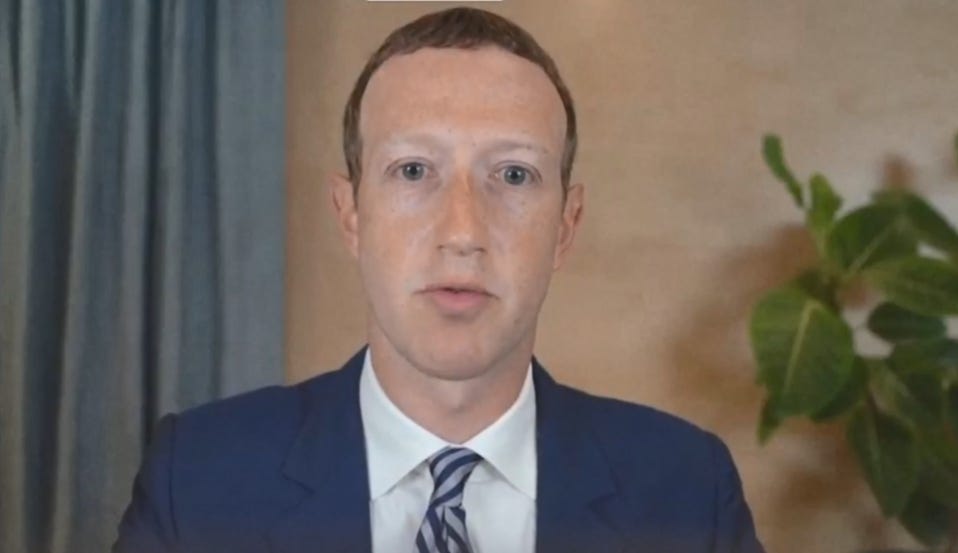Meta Verified is a sign of stagnation
Social media's best days are behind it, but companies will squeeze users as they decline
On Sunday, Mark Zuckerberg managed to pull the Oculus Quest headset off his face for a few minutes to approve a statement written a nameless comms person to inform the world he’s adding a price tag to Facebook and Instagram. While his focus has clearly turned to the digital realm where he assures us legs will one day exist, he still has to spare a thought for the social media platforms that actually make the company its money lest investors say some more mean things about his management style. (They can’t actually fire him.)
So, what did our Augustus Caesar cosplayer announce? Starting soon, users of Facebook and Instagram will be able to sign up for Meta Verified: a new subscription service that will provide a verification mark (once their government ID is checked), more “protection from impersonation,” a boost to subscribers’ posts, and a human to talk with when they run into a problem. (That last part seems like the big selling point.) They’ll get all that for the not-so-low price of $11.99 a month (or $14.99 on iOS) when it finally launches in the United States, but first Australians and Kiwis will get to test drive it for a considerably higher price, reflecting their exchange rates.
So, what should we make of this? A few things, in order of least to most important.
What to Make of Meta Verified
First of all, Elon Musk gets some of the blame for this. Yes, there are other factors, but if he hadn’t turned Twitter Blue into a paid verification service after taking over that platform a few months back, there’s no way Zuckerberg would have done it too. Meta’s service will likely have a smoother rollout as they get some of their exploited and poorly paid content moderators to check IDs and usernames before slapping a verified badge on someone’s account. (Meta won’t be taking away existing badges, like Musk still says he plans to do on Twitter.)
Meta Verified is also a sly way for Zuckerberg to get closer to his stated ideal of having the platform verify everyone’s real names, without actually having to force each user to go through that process. Instead, if you pay for the privilege, the platform will give you some perks — it’s a carrot instead of a stick.
But the biggest thing this shows us is that the model these social media platforms were built on is in deep crisis. Facebook has a large legacy userbase, but has been stagnating and failing to attract young people for years while many of the older users who feel trapped on it stay in spite of the user experience, not because of it. It’s all network effects. Meanwhile, Instagram is always trying to keep up with more engaging platforms, only to piss off the users who liked it as a photo-sharing service, not a subpar TikTok clone. It’s not just that users are souring on the platforms though; they’re simply not able to grow their revenues like they used to.
The Model is Broken
For years there have been questions over whether Facebook’s targeted advertising is anywhere near as good as it claims. It’s not a mind-control machine and has long obscured data that showed its ads weren’t as effective as it led advertisers to believe. (Not uncommon in the digital ads space.) But it’s faced even more pressure in the past couple years. In 2021, Apple limited ad tracking on its devices, a move Facebook said would cost it $10 billion in ad revenue in 2022, though the impact may have been even deeper. On top of that, Amazon is taking a bigger share of the digital ad market, users are spending less time online than earlier in the pandemic, and recent economic challenges have reduced ad spending.
The agreement for the better part of two decades has been that companies would let us use their social media platforms for free, and in exchange we’d let them harvest our data, post free content for them to run ads against, and look at those ads as we scrolled through everyone else’s posts. Even before the pandemic, that model was already strained, but the end of low interest rates and the pandemic tech boom is forcing companies to show investors they can find new ways to deliver revenue growth.
Meta Verified is one piece of that puzzle, but it’s guaranteed to disappoint just as Twitter Blue has done. How many people are really going to start paying for Facebook and Instagram after all these years? I can’t imagine it will be enough to make much of a difference to the bottom line of a massive company like Facebook. But it’s one part of a wider effort.
Facebook already tried to launch a subscription newsletter service to capitalize on that trend and failed. It’s also started toying with NFT integration, and has launched a clothing store for users to dress up their avatars. That latter piece is part of a push to create a marketplace for digital goods that it wants to massively expand as it herds its billions of users into the metaverse — or at least hopes we’ll accept its prods to join. The metaverse is ultimately not just an effort to expand revenue-generating opportunities beyond data-driven advertising into fees from a large virtual economy, but also to gain control over what it sees as the future of the internet and the hardware we use to engage with it so it’s no longer at the mercy of companies like Apple that can threaten its business with the flip of a switch. It wants to move into that position itself.
I’ve been very critical of the push for a “web3” over the past couple years. The concept was quickly captured by industry players and used to promote a future that would only deepen commercialization and financialization by building new means for transactions and speculation into much more of the web, all under the guise of empowerment. But some of the interest in it showed a desire for something different, and a recognition that the current paradigm seems to have reached its limit.
It Will Only Get Worse From Here
While the crypto boom may have crashed, elements of the corporate web3 vision persist. Free access will become more restricted to encourage people to upgrade to subscriptions and make transactions that will generate more revenue. Meta Verified is an optional service, but recent changes at Twitter show where it could be headed.
After the relaunch of Twitter Blue as a paid verification service, Musk has been slowly altering the experience for non-paying users, most recently by cutting off access to two-factor authentication via SMS. He also ended free access to Twitter APIs, placing them behind an extortionate paywall, and plans to prioritize the posts of paying accounts in future, which could further alter the experience of using the website. It would not be surprising to see other platforms follow suit.
A little over two years ago, I wrote about the challenges facing ad-based platforms like Google and Facebook and where things could be going next, laying out three potential futures: one where there’s further consolidation and expanded corporate power; another where they’re challenged by a proliferation of smaller services; and a third where the government steps in to fund technology to serve the public good. At the time, I speculated that
Facebook and Google would have the cash reserves to survive an ad crash, but that doesn’t mean a big hit to their primary revenue source wouldn’t make them vulnerable. They would have to swiftly find a new business model that would likely see their previously free services supplemented with subscriptions, if not placed behind a paywall entirely. Imagine a Facebook that limits the number of friends you can add unless you buy a subscription, offers an ad-free tier, or requires payment to create groups and pages.
As much as I would love to see a vibrant ecosystem of public technology, I’d have to put my money on the first of those three possible outcomes if I was being realistic. The model some of these companies relied on may be in jeopardy, but that doesn’t mean what comes next will be any better. If history has any lessons, it’s that companies love a good crisis they can use to squeeze us even more.





